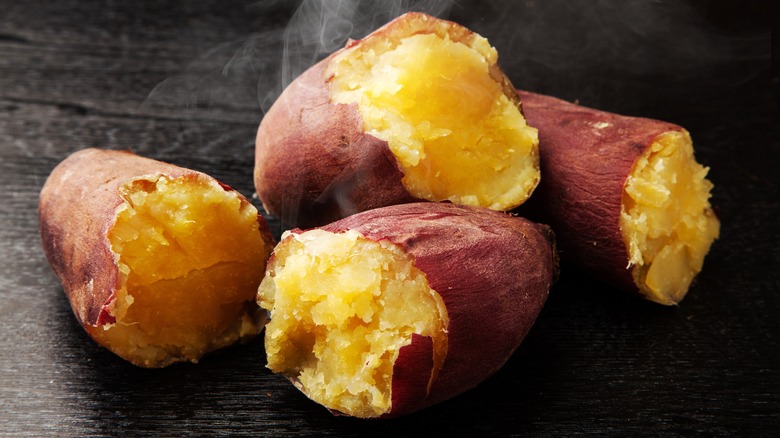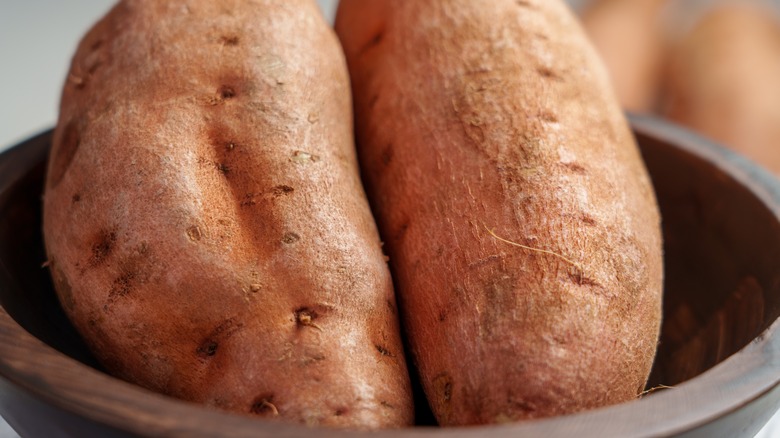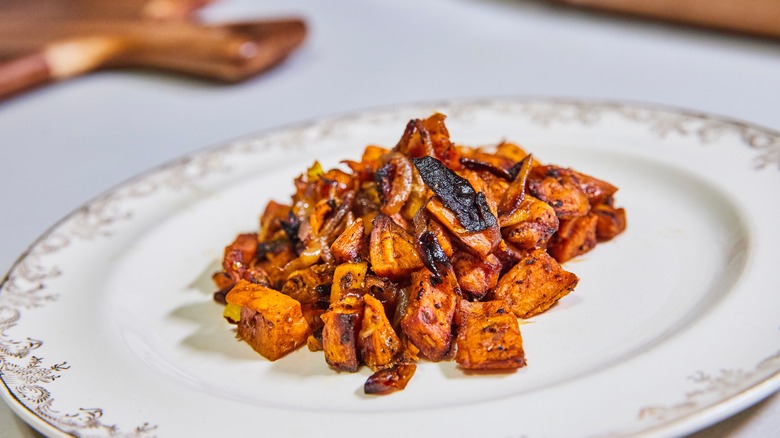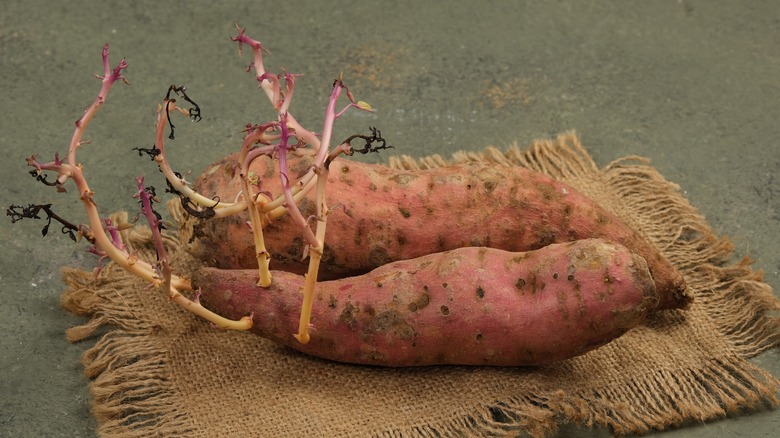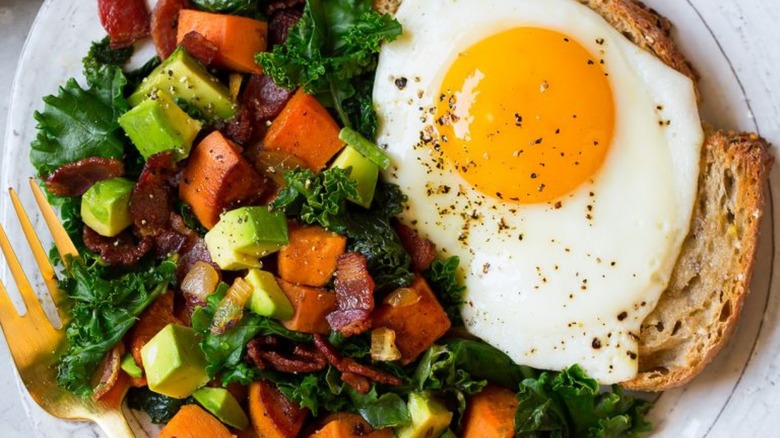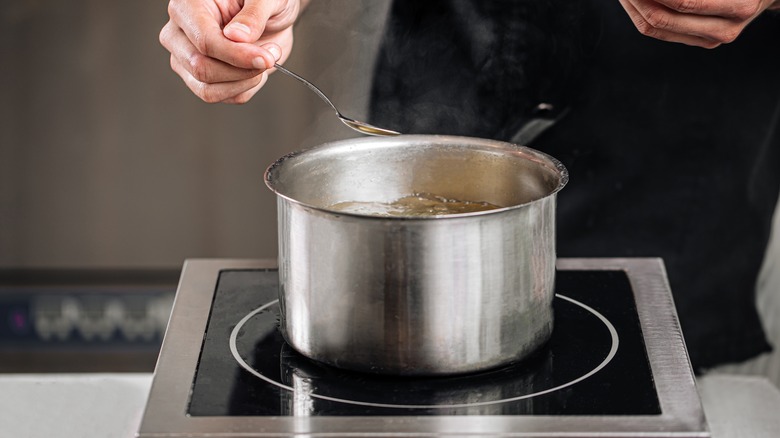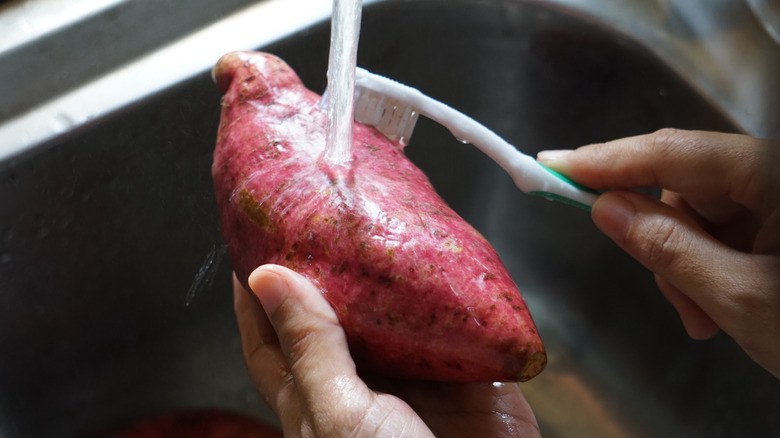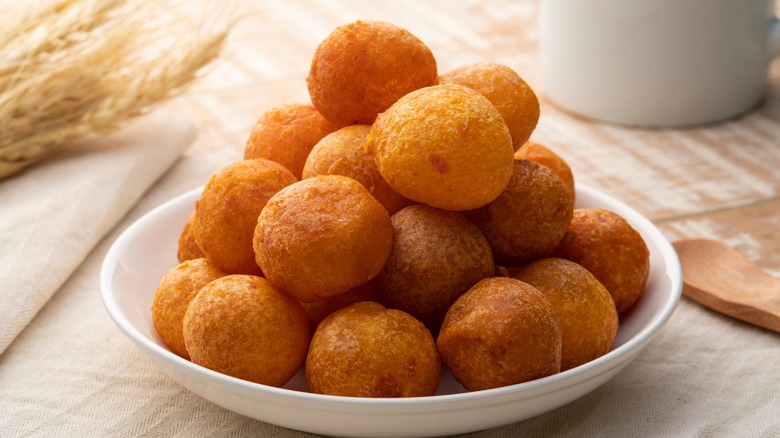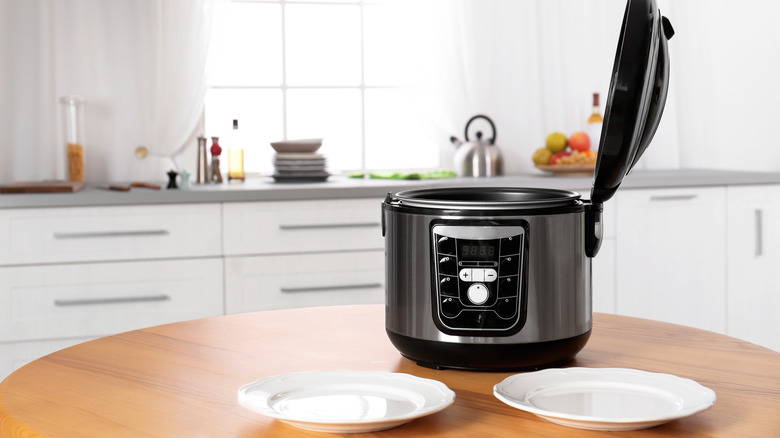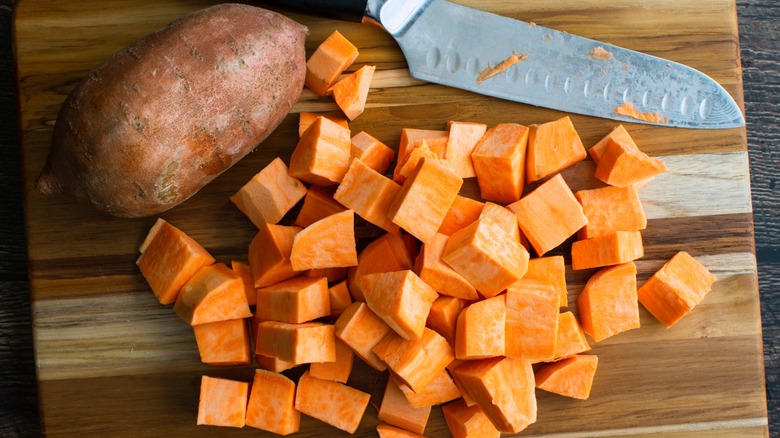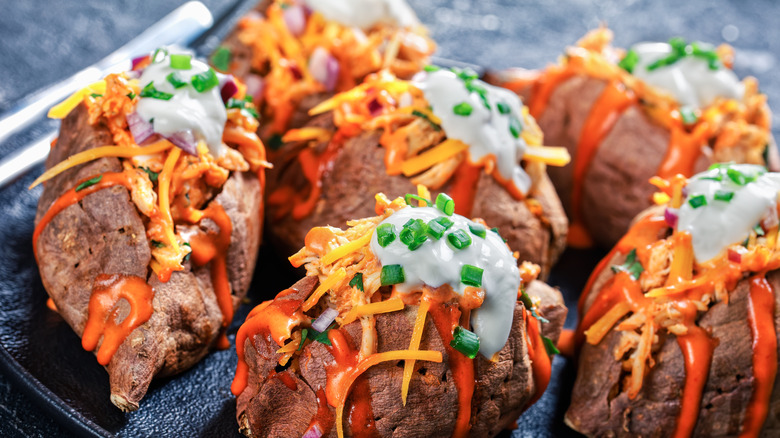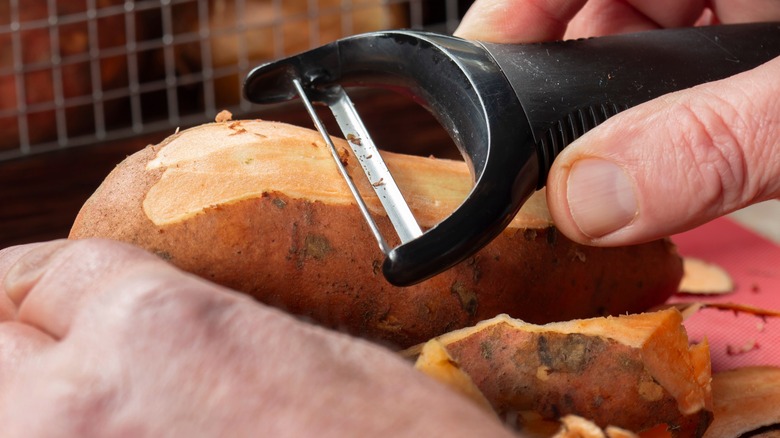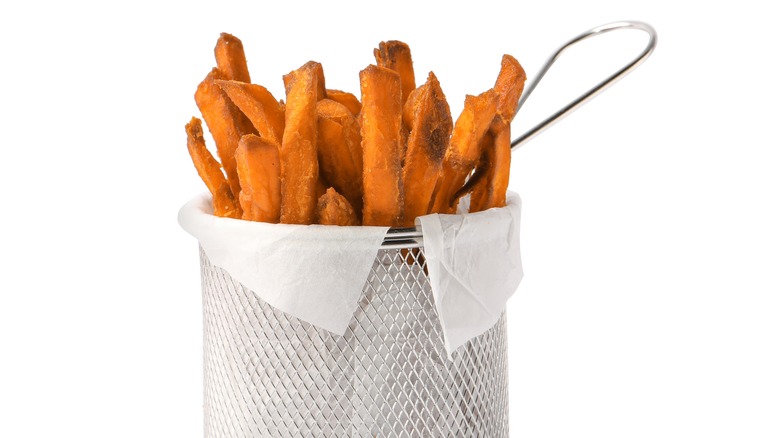You've Been Making Sweet Potatoes Wrong This Entire Time
With vibrant orange flesh and the ability to do everything a regular potato does (but with more panache), sweet potatoes have become a go-to root vegetable for some home cooks, whether they're baking, roasting, or turning them into fries. However, sweet potatoes can be tricky to prepare, and there are a few mistakes that even experienced home cooks make from time to time.
From burning wedges to storing the raw vegetables in the fridge — who knew? — we've likely all made a few of these mistakes over the years. And sometimes the biggest mistake is failing to realize the true potential of these fabulous spuds, and instead turning out the same tired dishes every time. Join us as we uncover the 12 most common mistakes you may be making with your sweet potatoes. The good news is they are easily fixed, and armed with this knowledge you can be sure to start making sweet potatoes the right way — so they come out perfectly every time.
Storing sweet potatoes in the fridge when raw
When you get home from the grocery store with your shopping, it's second nature to put your sweet potatoes in the fridge along with the rest of your vegetables, perhaps in the dedicated drawer to keep them extra crisp. But storing your sweet potatoes at such a low temperature can actually be detrimental to their flavor and texture; it also makes them harder to prepare and cut all the way through. This is because keeping them cold changes the structure of the cells and causes the flesh to become harder. Although storing them at a low temperature will stop them spoiling as quickly, it probably isn't worth the trade-off in terms of flavor and texture, so store them in a cool, dark cupboard instead.
If you have sweet potatoes that have already been chopped, however, you should store them in the fridge until you are planning to cook them. You can store them in water to keep them as fresh as possible, but try to eat them within a day. By storing your raw sweet potatoes correctly, you can get the perfect balance between keeping them fresh and making them easy to prepare.
Overcooking and burning oven-cooked sweet potatoes
The reason sweet potatoes are so utterly delicious when roasted is that the sugars caramelize as they cook, creating a sweet flavor that puts them way ahead of most other root vegetables. That same sugar, however, can burn and turn bitter if you cook them for too long, so it's important to get the cooking time and temperature right to prevent ruining your dish.
The smaller and thinner you cut your pieces, the quicker they will cook. If you're making wedges or oven-cooked fries, cutting them a bit thicker can help prevent the edges from burning by the time the centers are cooked. You should also consider which part of the oven you use. Most of us tend to favor the middle shelf, either because it's the most convenient or we assume it will get the best distribution of heat. However, sweet potatoes actually benefit from being placed on the top rack instead. At the top of the oven, they will caramelize more slowly, meaning fewer burnt spots spoiling the delicious orange flesh. If your sweet potato fries are regularly burning, try turning down the oven and cooking them low and slow instead. They may not crisp up as much, but they will cook through without the charred edges.
Using sweet potatoes that are starting to go bad
In the name of reducing food waste, most of us try not to throw out produce that is still edible, even if it's past its prime. At their best, sweet potatoes should have smooth skin and feel firm to the touch. When you cut into them, you may see a white milk-like substance appear and worry that it's a sign of spoiling, but it's actually an indication that your sweet potato is fresh. That sap is the sugar and starch in the vegetable being released along with moisture, which happens less as the potato gets older and dries out.
The key is being able to spot the difference between a sweet potato that is just starting to spoil but is still safe to eat. As they age, sweet potato skins may wrinkle slightly, and sprouts may begin to form. Sweet potatoes that have begun to sprout can still be eaten safely, but once they are at this stage, their nutritional content will have decreased. However, if the flesh has gone soft or black, the potato is starting to spoil and should be discarded; and if it smells off, it's best to give it a pass even if it looks okay.
Not appreciating the versatility of sweet potatoes
Although sweet potato fries rank pretty highly on the awesomeness scale, they are by no means the only way to eat this beautiful vegetable. As well as the usual methods of preparation, sweet potatoes can benefit from a bit of outside-the-box thinking, transforming them into creative side dishes and accompaniments. The first mistake you may be making is starting your day without a sweet potato breakfast. If you're in the mood for a fried breakfast or brunch, try this delicious sweet potato and sausage hash. Diced sweet potato roasted in the oven then served with onions, garlic, and sausages — need we say more?
Sweet potatoes are a great way to add extra nutrition to bread, as in these sweet potato burger buns. They provide moisture and keep the bread light and airy, a perfect vehicle for a rich, meaty burger. Or, if you're looking for a side dish but want to go beyond the usual fries, try Hasselback sweet potatoes instead. By cutting most of the way through the potato before roasting, you create a visually appealing accordion-shaped dish that will happily soak up any toppings you fancy. Exploring exciting new dishes with sweet potatoes will help you get out of a food rut and create dishes with bold flavors and textures. While sweet potato fries will always be a favorite, your bright orange spuds can contribute more than that from now on.
Boiling sweet potatoes instead of roasting
Even though they're only distantly related, sweet potatoes behave like regular white potatoes in a lot of ways, and there are many ways of preparation that will work for both. They both make great chips, are excellent when baked and stuffed with cheese and other goodies, and can be mashed to make a luxurious side dish. But while boiling your white potatoes is a common way to cook them, this method is not advisable for sweet potatoes if you want them to be at their best in terms of flavor and texture.
Compared to roasting, boiling sweet potatoes can make them overly watery and drain the flavor from them. Roasting them causes the sugars inside to caramelize, which results in the delicious sweet flavor that we all love. The chemical reaction when you boil them is completely different, and doesn't result in the same depth of flavor. When vegetables are roasted, they lose water, meaning you get a more concentrated flavor. When you boil them, the opposite happens, and the flavor ends up diluted.
Though there may be certain recipes that call for boiled sweet potato, in general you should roast them whenever possible. It takes very little effort to roast them anyway, and you will be guaranteed beautifully caramelized vegetables with a delicious sweet flavor.
Not washing the vegetables before you cook them
If you're in a hurry to get dinner made after a busy day or have hungry children looking pleadingly at you, it can be tempting to skip the step of washing your sweet potatoes. That's not a good idea, as these vegetables grow far underground and are exposed to lots of different microorganisms in the soil. And, though you may like to prepare in advance, it's better not to wash the sweet potatoes as soon as you bring them home from the grocery store. The higher the moisture content, the more likely it is that mold could form, causing them to spoil quickly. Instead, wash them half an hour or so before you plan to cook them by soaking them in warm water for at least 10 minutes, then scrubbing them with a vegetable brush.
If you're planning to eat the skins, washing them thoroughly is even more crucial, though it's important even before peeling them, as bacteria can be transferred on the flesh as you peel them. The good news is that sweet potatoes are on the "Clean Fifteen" list published by the Environmental Working Group, meaning they absorb fewer pesticides than most other crops, so washing them thoroughly with water should be good enough.
Skipping a decadent sweet potato dessert
Most of us use sweet potatoes in savory dishes, and you can understand why. Whether roasted, fried, or mashed, they have a brilliant way of bridging the gap between sweet and savory and adding a honeyed flavor to otherwise rich dishes. However, they can also be put to great use in desserts — the clue is in the name, after all — and they can add a creamy texture to your sweet treats, as well as a nutritional boost.
Their hearty nature means that sweet potatoes make a great addition to bread pudding, adding moisture and a subtle sweetness that means you can use less sugar. And considering the vitamins and fiber that sweet potatoes contain, you can enjoy a delicious dessert while still being conscious of your health. If chocolate is your thing, then pecan sweet potato brownies are going to make you happy. This recipe doesn't even need flour, as the texture of the potatoes is enough to hold it all together to make a gooey, sumptuous treat. If you want to impress at a dinner party, serving a sweet potato tarte tatin will turn the heads of your guests, as the caramelized vegetable replaces the usual apples perfectly.
The incredible versatility of sweet potatoes means the options for desserts and sweet treats are endless. By experimenting with sweet potatoes in your baking, you may just invent a new signature dish that will show the potential of this humble ingredient.
Not utilizing the slow cooker, multi-cooker, or air fryer
If you have a slow cooker, you will know what a crucial kitchen appliance it has become. To be able to add food before you leave in the morning and have a perfectly cooked meal to come home to is life-changing, and you can use it to simplify your sweet potatoes too. Cooking them low and slow will allow the sugars to caramelize and result in a beautifully fluffy potato.
To create the perfect slow-cooked sweet potatoes, cook them for around six or seven hours, or until they are perfectly tender. Keep the skins on; like many fruits and vegetables, there's plenty of nutrition to be found in the peel. By the end of your cooking time, you'll have soft and tender vegetables that can be loaded up with your favorite toppings or served alongside an entree.
If you have a pressure cooker or Instant Pot, you can use that for your sweet potatoes too. Add them to the pot with the appropriate amount of water for your cooker and pressure cook them for around 15 to 20 minutes, depending on how large they are. Let the pressure release naturally, then drain the water and serve. In both cases, the cooked sweet potato can be crisped up in the oven or air fryer to create the perfect crispy exterior.
Not cutting sweet potatoes evenly
The perfect sweet potato should be slightly caramelized, but still soft and tender in the middle, without too much charring on the outside. To get it all right, it's important to give some thought to how you prepare the raw vegetables before making sure the cooking is spot-on.
When preparing any vegetables to be cooked, cutting them into uniform pieces is key. If some pieces are larger than others, they will be under-cooked in the middle, or the smaller ones will end up burnt. When making fries or wedges, make equal-width slices into the potato, and trim them all to the same length. A sharp knife will help you in this task, as sweet potatoes can be notoriously hard to cut through, and the sharper the knife, the easier it will be to cut uniform pieces.
Once you have your evenly-sized shapes, be sure to spread them out on the baking tray in one single layer. The aim is to caramelize them and bring out the lovely sweet sugars, and crowding them in the pan can cause them to steam rather than roast, which will be a big disappointment.
Sticking with the same old toppings
A baked sweet potato is a wonderful, nutritious meal that serves as either a filling lunch or a light dinner. Most of us play it safe and stick to the same toppings every time — cheese, sour cream, or simply a dollop of butter. While there's nothing wrong with any of these, you're missing out on some stunning flavor combinations by not trying more interesting toppings.
If you still need to keep things quick and simple, opt for a Mediterranean twist with some hummus, tomatoes, and feta. This protein packed option will feel light as you eat it, but keep you full for the rest of the day. If you have a bit more time on your hands, try whipping up some fajitas-style veggies to add to your sweet potato. To up the Tex-Mex vibe even more, add some pinto beans and a generous squeeze of lime for a fresh topping that is bursting with flavor.
Finally, use any leftovers you have in the fridge as toppings to reduce food waste and invent a delicious dish at the same time. Curry, pulled pork, or ratatouille will all work brilliantly and make a hearty family meal without you having to put in too much effort.
Ditching the skins
Quite often, the first thing people do when preparing a sweet potato — or any kind of potato — is to get the vegetable peeler out and remove the skins. But did you know you can save yourself a lot of time, reduce food waste, and increase the nutritional profile of your dish all by simply leaving the skins on?
Sweet potatoes in general are packed with nutrition, and much of that is found in the skin. An average sized sweet potato with its skin intact has more than 150% of the recommended intake of vitamin A, as well as healthy doses of vitamin C and potassium. Much of the fiber is also found in the skin, so removing it will deprive your digestive system of essential roughage to keep things moving smoothly.
If you don't want to keep the skins on for your recipe, you can peel the sweet potato then use the skins separately. Deep fry them or roast them to make crunchy chips that are the perfect balance between sweet and savory.
Not using creative seasonings on your sweet potato fries
Sweet potato fries have become a bit of a culinary revelation in recent years, and no wonder. Crunchy and sweet, their flavor and texture match with so many dishes, from burgers to grilled fish. A little bit of seasoning really lifts the flavor, but if you've been sticking with salt and pepper, you are missing out on the chance to inject some extra depth into your dish.
The sweet tones from the potatoes allow you to use unusual seasonings that may not work with regular white potatoes. Cinnamon and nutmeg, for example, will enhance the sugars while still providing spicy notes to pair them with savory dishes. Alternatively, you could turn them into a sweet snack with cinnamon, nutmeg, and a dash of sugar. If you want to go the spicy route instead, adding paprika or cayenne pepper will give the sweet potatoes a pleasant kick. Or, for a luxurious touch, grate parmesan cheese over the top as they come out of the oven along with a drizzle of truffle oil.
By pushing the boundaries on your usual seasonings, you can discover flavor pairings that work brilliantly, and switch up your sweet potato fries every time you make them. No matter what you serve them with, a touch of extra seasoning will give them an extra flavor punch.

